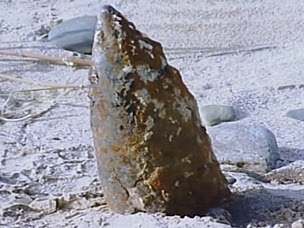By Claire Marshall
Bomb disposal teams in the South West have dealt with double the number of unexploded ordnance than in the same period last year.
Since mid December, the Royal Navy’s Southern Dive Unit has recovered or disposed of 244 items of ordnance.
During the same period last year, they dealt with just 108 items.
Almost 70 years after the end of WWII, one legacy of that conflict continues to turn up on beaches and harbours around Britain.
Unexploded shells, bombs and mines continue to be discovered every year, and the Royal Navy’s Southern Dive Unit is tasked with making these devices safe.
Its area of responsibility stretches for some 2,250km (1,400 miles). It begins from the highwater mark in Hull and proceeds seaward to the territorial limit, and then runs clockwise around the British Isles – including the Isle of Wight, Channel Islands, and Isles of Scilly – to finish in Liverpool.
Thanks to the unremitting storms and wild weather that have hit the UK since mid-December, these divers have been busier than ever. The unit has been responding to emergency calls almost every day.
The divers have had to deal with a British anti-submarine mine discovered by surfers in Haverfordwest in Pembrokeshire, and a rare WWI German mine that was found on a beach near Newquay in Cornwall.
“The explosive is normally of very high quality,” said Chris O’Flaherty, the commanding officer of the Fleet Diving Squadron.
“The Germans were very good engineers. A number of them aren’t viable but an awful lot of them are, and we prove that regularly by the manner in which we dispose of them.
“The explosive deteriorates and the main charge is usually relatively stable. It’s the detonator that’s the dangerous part.”
I ask him why so few people have been injured by unexploded ordnance. He replies: “Good fortune.”
The unit was called out to Braunton in Devon last weekend to defuse a live shell found by local couple Phil Naylor and his wife Sue. The storms have scoured away the sand dunes where they normally walk.
“Sue pointed at something, and it was definitely suspicious,” said Phil. “It looked like the tip of a bomb or a missile. I went a bit closer to make certain that’s what it was. I used to be an RAF armourer and recognised it to be an artillery shell.”
Phil’s grandfather, born in Braunton, would have trained on this very beach for the D-Day Landings.
“This shell would have been one of thousands fired here to simulate what the poor guys would find when they hit the beaches [in France],” said Phil.
“It’s quite weird to think that he might have seen that shell flying over his head.”
Coastal engineer Andy Bradbury walks over the ribbon of shingle that makes up Hurst Spit in Hampshire. The crunching sound of his feet is muted by the grumble of diggers and other heavy machinery at work on the beach. New Forest District Council has a lot of rebuilding and reinforcing to do.It’s not just walkers that need to be careful.
“It’s been a very rough winter,” he says. “During the storms there were about 100,000 tonnes of material redistributed around the beach. When this happens, it unearths all kinds of bits and pieces that you really don’t want to see.”
At a key point at the opening to the Solent, Hurst Castle was built by Henry VIII to guard the approaches to Southampton. It has been used as a military base on and off ever since.
Andy points towards the castle. “We know they used to practice firing from there. We have found items spanning several hundred years. Explosives used back in the late 1800s are often more dangerous than more recent devices.”
He explains that when “lyddite”, an early type of high explosive, dries out it can become very unstable.
Just the night before, the unit dealt with a shell uncovered on the beach. Seven more had been found over the weekend.
He looks down into the crater left by the ordnance. “All of the machine drivers are briefed on what they do,” he says. “They are told not to touch anything. It may be dangerous.”
Fonte:
http://www.bbc.com/news/science-environment-26382127
Foto: B.B.C.







Lascia un commento